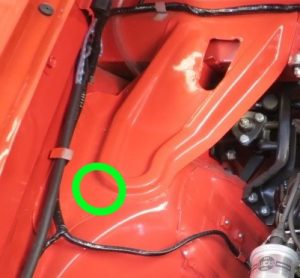There were several changes to the body, interior, drive train and various components over the production run of Metropolitans. This page has some information to help you decipher the specifics of your car, and to help you choose the right parts when ordering.
CHASSIS SERIAL NUMBER:


The Chassis Serial Number can be found on the small plate under the hood, on the right side of the firewall. It is held in place with two screws and can easily be lost or switched. Therefore, it can also be found stamped onto the top of the right side shock tower just in front of the diagonal brace (but very early model cars may not have this stamped number). Any parts which do not work for all years of Metropolitans are specified in the catalog with “up to” or “begin” followed by the applicable chassis serial number. Many parts changes happened mid-year. Also, the cars took at least 6 weeks to arrive at the US or Canadian distribution centers from the factory in Longbridge, UK, and often sat on a lot for some time before being sold. Cars were titled when sold, so the date on the title will likely be later than the production date. The chassis serial number is the best way to identify the correct parts for your car.
Here is a chart showing approximate production dates:
BODY ID TAG:

The Body ID tag contains numbers for “Body”, “Model”, “Trim” and “Paint”.
The Body number is a production number for the body which has no direct correlation to the Chassis Serial Number.
The Model number refers to the series and if the car is convertible or hardtop. There are obvious visual differences between the series aside from many other changes. Series I & II cars have a solid color on the body, along with a horizontal bar-shaped grille and chrome hood scoop. Series III & IV cars have two colors on the body separated by stainless steel side trim, along with a waffle-pattern grille and flat hood.
- 541 = Series I & II convertible
- 542 = Series I & II hardtop
- 561 = Series III & IV convertible
- 562 = Series III & IV hardtop
The Trim number refers to the interior. There were no options available, so the trim depended on the series. “T-1” came in Series I & II cars and consisted of yellow and black striped fabric trimmed in tan vinyl. “T-600” came in Series III cars and consisted of black & white houndstooth fabric trimmed in black & white vinyl. “T-900” & “T-971” came in Series IV cars and consisted of grey diamond-pattern fabric trimmed in black and white vinyl.
The Paint number can be deciphered in the chart below:

ENGINE IDENTIFICATION:

The engine number can be found on the right side of the block, just under the head in the center. There were four different engines used throughout production.

1200cc “A-Series” – The engine numbers begin with prefix “1G” and were installed in cars with serial numbers E1001 – E11000. “Austin” script is cast into the lower right rear corner of the block, just above the starter. This is a completely different block from the later engines. It is shorter and uses the shorter transmission with a mechanical clutch.
 1200cc “B-Series” – The engine numbers begin with prefix “2G” and were installed in cars with serial numbers E11001 – E21007. “1200” is cast into the lower left front corner of the block. This is a similar block to the 1500cc engines and many parts are interchangeable. It uses the longer transmission and a hydraulic clutch.
1200cc “B-Series” – The engine numbers begin with prefix “2G” and were installed in cars with serial numbers E11001 – E21007. “1200” is cast into the lower left front corner of the block. This is a similar block to the 1500cc engines and many parts are interchangeable. It uses the longer transmission and a hydraulic clutch.
1500cc “Low Compression” – The engine numbers begin with prefix “1H” and were installed in cars with serial numbers E21008 – E43115. “1500” is cast into the lower left front corner of the block. It uses the longer transmission and a hydraulic clutch.

1500cc “High Compression” – The engine numbers begin with prefix “15 C-N-H”, “15 A-N-H” or “15 F-N-H” and were installed in cars beginning with serial number E43116 through the end of production. “1500” is cast into the lower left front corner of the block. It uses the longer transmission and a hydraulic clutch. This engine has a canister oil filter with a return line on the right side of the block.
TRANSMISSION IDENTIFICATION:
There were three different transmission cases used throughout production. 1200cc A-Series transmission is much shorter than the other two at 21″ long and uses a mechanical clutch (up to E11000). The 1200cc B-Series and 1500cc engines are mated to a longer 32″ transmission which uses a hydraulic clutch. There are two versions of this transmission. The first (E11001-E59047) has the starter mounted about halfway up the right side (“low mount”) and uses a 3/16″ thick engine rear plate to mount. The other (begin E59048) has the starter mounted about 2/3 up the right side (“high mount”) and uses a thicker 3/8″ engine rear plate.



HELPFUL & INTERESTING LINKS:
Nash Metropolitan on Wikipedia
Metropolitan Owners Club of North America
Metropolitan Owners Club of North America Library
Internet Movie Car Database (Metropolitan on the screen)
British Pathe early Metropolitan production video
The “Metronator” drag racing show car sponsored by Metropolitan Pit Stop

